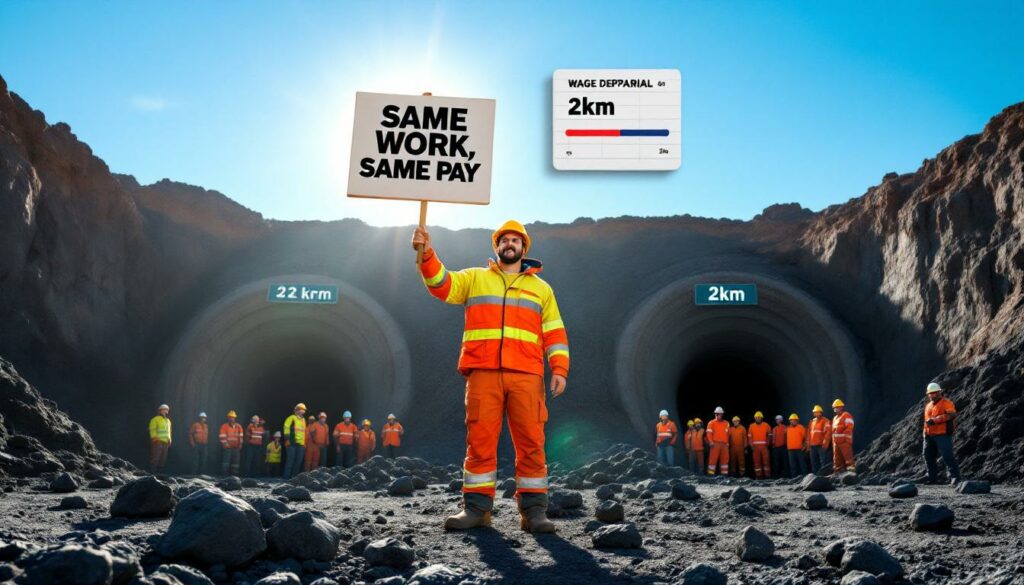Workers at Glencore's Australian Coal Mine Strike: Understanding the Pay Gap Dispute
The 24-Hour Strike Action at Ulan Coal Mine
On July 9, 2025, workers at Glencore's Ulan underground coal mine in New South Wales, Australia initiated a 24-hour strike that halted midweek shift operations. The industrial action came after 16 months of enterprise negotiations that failed to resolve significant wage disparity issues between mine sites. The Mining and Energy Union (MEU) members voted overwhelmingly to stop work, marking a critical escalation in the ongoing labor dispute.
The strike began Wednesday afternoon, with workers leaving their posts in a coordinated effort to bring attention to their wage concerns. According to union representatives, the strike participation rate exceeded 90% of eligible workers, demonstrating strong solidarity among the mine's workforce.
"This wasn't a decision our members took lightly," stated the MEU NSW South-West District vice president. "After nearly a year and a half of negotiations going nowhere, the workers felt they had no choice but to take this step."
The Central Issue: Same Company, Different Pay
The heart of the dispute centers on a straightforward principle: workers at the Ulan Underground mine receive significantly lower compensation than their colleagues performing identical duties at the Ulan West mine, despite both operations being owned and operated by Glencore and located merely two kilometers apart.
"We work for the same company, doing the same work just two kilometers down the road. We should be on the same base rate," emphasized the MEU NSW South-West District vice president in a statement to Reuters.
Industry analysts estimate the wage gap between the two operations ranges between 15-18%, though exact figures remain undisclosed in public documents. This disparity has created growing tension as workers at both sites frequently interact and are aware of the compensation differences despite performing identical mining operations.
Why Are Workers Demanding Equal Pay?
The "Same Work, Same Pay" Principle in Practice
The workers' position aligns with Australia's foundational labor principle of equal pay for equal work. Under the Fair Work Act, this principle is recognized as a core element of workplace fairness, though implementation across complex corporate structures often remains challenging.
Labor law experts note that while Glencore technically operates the mines as separate business entities with different enterprise agreements, the proximity and operational similarities make the disparity particularly problematic from both legal and ethical standpoints.
"When you have workers performing identical tasks with identical qualifications and safety responsibilities just minutes away from each other within the same corporate umbrella, maintaining different pay scales becomes increasingly difficult to justify," explains Dr. Helena Thompson, labor relations professor at the University of Melbourne.
A Timeline of Failed Negotiations
The path to this week's strike reflects a lengthy but unproductive negotiation process:
- March 2024: Initial enterprise agreement meetings begin
- June 2024: Union presents formal proposal for wage standardization
- September 2024: Glencore counters with below-inflation increase offer
- December 2024: Mediated talks through Fair Work Commission stall
- February 2025: Workers reject Glencore's "final offer"
- April 2025: Union applies for protected industrial action ballot
- June 2025: Members vote to authorize strike actions
- July 2025: 24-hour strike commences
Throughout the negotiations, the MEU claims Glencore has repeatedly refused to discuss standardizing base rates between the two operations, citing "historical differences in operational structures" – an explanation workers find inadequate given the identical nature of their work.
How Does This Strike Fit Into Australia's Mining Labor Landscape?
Recent Trends in Mining Labor Disputes
The Ulan mine strike represents part of a growing pattern of labor actions across Australia's resource sector. According to the Australian Bureau of Statistics, industrial disputes in the mining industry have increased by 18% year-over-year from 2023 to 2025, with pay disparities and working conditions being the primary catalysts.
"What we're witnessing is a recalibration of power in labor negotiations. With skilled labor shortages persisting across Australian mining operations, workers have gained significant leverage in wage discussions," notes the Mining.com editorial team in their June 2025 Australia Labour Trends Quarterly report.
Recent comparable actions include:
- BHP's Queensland coal operations (2024): A 12-day strike resulted in a 14% wage increase over three years
- Yancoal Hunter Valley operations (2024): Workers secured improved safety protocols and an 8% pay increase after a series of rolling stoppages
- Whitehaven Coal's Narrabri mine (2023): A five-day strike led to standardized overtime rates across shifts
Economic Impact of Coal Mining in New South Wales
Coal remains a cornerstone of New South Wales' economic framework, with 2024 exports valued at approximately A$25.6 billion according to the NSW Department of Regional NSW. The industry directly employs over 22,000 workers in the state, with an estimated 67,000 additional indirect jobs dependent on mining operations.
The Central West region, where the Ulan complex is located, is particularly dependent on mining employment, with approximately 36% of the local workforce connected to resource extraction activities. This economic concentration amplifies the significance of labor disputes beyond the immediate parties involved.
Who Are the Key Stakeholders in This Dispute?
Mining and Energy Union (MEU)
The MEU represents over 80,000 workers across Australia's resources sector and has been the primary advocate for the Ulan Underground workers. Formed through the merger of several resource-focused unions, the MEU has developed significant expertise in negotiating enterprise agreements across the coal industry.
The union has successfully negotiated standardized wages across other multi-site mining operations, including Glencore's Hunter Valley complex in 2022. This precedent has strengthened their position that the Ulan disparity represents an anomaly that should be addressed.
"Our members understand market realities, but they also recognize when they're being treated unfairly compared to colleagues doing identical work," stated the MEU's national secretary in a press release supporting the Ulan action.
Glencore's Position and Operations
As one of the world's largest diversified natural resource companies, Glencore operates 17 coal mines across New South Wales and Queensland, making it Australia's largest coal producer. The Ulan complex, comprising both the Underground and West operations, produces approximately 11 million tonnes of thermal coal annually, primarily for export to Asian markets.
While Glencore has not publicly commented on the current strike, industry analysts suggest the company's reluctance to standardize wages likely stems from concerns about setting precedents across their diverse Australian operations.
"Glencore's silence reflects standard corporate strategy during sensitive negotiations," explains an industrial relations professor from the University of Melbourne. "They're likely calculating the financial implications of wage standardization not just at Ulan, but potentially across their entire Australian portfolio."
The company's 2024 annual report acknowledged "ongoing enterprise agreement negotiations" at several Australian sites but provided no specific details regarding the Glencore operational challenges at Ulan.
What Are the Potential Outcomes of This Strike?
Possible Resolution Scenarios
Based on similar disputes in Australia's mining sector, several potential outcomes appear most likely:
-
Full standardization: Glencore agrees to gradually equalize pay rates between the two operations over a defined timeframe (typically 2-3 years).
-
Partial convergence: A compromise raising Ulan Underground rates significantly but not to full parity with Ulan West.
-
Enhanced benefits package: Maintaining some base rate differences but adding improved non-wage benefits (superannuation, allowances, leave provisions) to compensate.
-
Extended industrial action: If initial negotiations fail, workers could implement rolling stoppages or work restrictions, potentially escalating to more extended strikes.
Fair Work Commission statistics indicate that approximately 75% of Australian mining strikes resolve within three weeks, with phased wage adjustments being the most common compromise solution.
Broader Implications for Mining Labor Relations
The outcome of this dispute could establish important precedents for Australia's mining sector, particularly regarding multi-site operations under single corporate ownership.
"How Glencore resolves this dispute will be closely watched by other mining companies with similar operational structures," notes labor economist Dr. James Fielding. "With Australia's mining workforce increasingly connected through social media and union networks, pay transparency between sites has never been higher."
Industry observers also point to potential regulatory implications, with the Fair Work Commission increasingly focused on standardizing conditions across companies with multiple enterprise agreements.
How Does This Compare to Other Mining Labor Disputes?
Recent Similar Cases in Australian Mining
The Ulan dispute parallels several recent Australian mining labor actions, though with some distinctive elements:
| Company | Location | Year | Duration | Key Issue | Outcome |
|---|---|---|---|---|---|
| BHP | Queensland | 2024 | 12 days | Base wage increase | 14% over 3 years |
| Yancoal | Hunter Valley | 2024 | 8 days (rolling) | Safety & wages | 8% increase, enhanced protocols |
| Whitehaven | Narrabri | 2023 | 5 days | Shift differentials | Standardized rates |
| Glencore | Ulan | 2025 | Ongoing | Site wage disparity | Pending |
What distinguishes the Ulan situation is the proximity of the two operations and the identical nature of the work, creating a particularly compelling "equal pay for equal work" argument.
International Context
Globally, mining labor disputes have increased 32% year-over-year from 2024 to 2025 according to the International Labour Organization, with wage standardization emerging as a common theme across multinational mining companies.
Notable international parallels include:
- South Africa: Sibanye-Stillwater's 2024 gold mine strike lasted eight weeks before resolving disparities between regional operations
- Chile: BHP coal strategy faced rolling stoppages in 2024 over site-specific allowance discrepancies
- Canada: Teck Resources negotiated a pre-emptive standardization agreement in 2023 to avoid threatened strikes
Australia's unique feature is its significantly higher union density in mining (55% compared to the national all-industry average of 14%), which tends to enable more coordinated industrial actions and potentially stronger negotiating positions.
What Are the Economic Implications of the Strike?
Short-term Production Impact
The immediate 24-hour strike at Ulan Underground will cause an estimated production loss of approximately 12,000 tonnes of thermal coal, based on the mine's average daily output. At current thermal coal prices of around US$140 per tonne, this represents roughly US$1.68 million in deferred production value.
Mining engineers note that underground operations face particular challenges with work stoppages, as safety protocols require comprehensive inspections before production can resume, potentially extending the actual impact beyond the formal strike period.
"Even a single-day underground stoppage typically results in 1.5-2 days of effective production disruption due to safety recommissioning requirements," explains mining safety consultant Richard Thornton.
Long-term Considerations
Should the dispute escalate to extended industrial action, more significant implications could emerge:
-
Operational costs: Industry models suggest standardizing wages between the sites would increase Glencore's annual labor costs by approximately 4-5% at the Ulan complex.
-
Market positioning: Extended disruption could impact Glencore's ability to fulfill certain term contracts, potentially benefiting competitor mines in the Hunter Valley.
-
Investor confidence: Labor disputes feature prominently in mining investment risk assessments, with prolonged unresolved actions typically triggering reassessment of future capital allocations.
-
Precedent effects: Resolution terms could influence upcoming negotiations at Glencore's other Australian operations, particularly those with multi-site structures.
Economic analysts generally consider a single day's action as "symbolically important but financially manageable" for a company of Glencore's scale. However, they caution that extended disputes in the current high-demand coal market could strengthen the union's negotiating position.
FAQs About the Glencore Coal Mine Strike
What exactly are the workers demanding?
Workers at Ulan Underground mine are seeking wage parity with employees at the neighboring Ulan West mine. While exact figures haven't been publicly disclosed, industry sources suggest the gap in base rates is approximately 15-18% for equivalent positions. The union argues that performing identical work for the same company just two kilometers away should result in equivalent base compensation.
How long could this strike last?
The initial action is scheduled for 24 hours, but the union has authorization for further industrial actions if negotiations don't progress. Based on comparable disputes in Australian mining, resolution typically occurs within 1-3 weeks of initial strike actions. However, particularly complex cases have occasionally extended beyond this timeframe, especially when broader precedent-setting principles are involved.
Will this affect coal prices or supply?
A short-term strike is unlikely to significantly impact broader coal markets or prices. Australia's thermal coal export capacity features sufficient flexibility to absorb brief disruptions at individual mines. However, extended industrial action at Ulan could potentially create localized supply tightness for specific coal grades if the dispute remains unresolved for several weeks.
Has Glencore faced similar labor disputes before?
Glencore has navigated various labor challenges across its global operations. In Australia specifically, the company resolved a similar wage standardization dispute at its Hunter Valley operations in 2022, ultimately agreeing to phase in equalized base rates over a three-year period. Internationally, Glencore's operations in South African coal dynamics and Colombia have experienced more prolonged disputes, sometimes lasting several months before resolution.
What happens if negotiations continue to fail?
If the parties cannot reach agreement independently, several escalation paths exist under Australian labor law:
- The Fair Work Commission can facilitate additional mediated discussions
- Workers could vote to extend or escalate industrial actions
- In extreme cases involving critical supply, the government has legal mechanisms to mandate arbitration
The most common outcome remains negotiated settlement, typically involving phased implementation of key demands with mutually acceptable timeframes.
In conclusion, the workers at Glencore's Australian coal mine going on strike over pay gap issues represents a significant development in the ongoing evolution of labor relations in Australia's resource sector. As the industry continues to navigate through evolving mining trends and economic pressures, fair compensation across operations remains a critical factor in maintaining productive workplaces and ensuring Australian resource exports remain globally competitive.
Wondering How to Profit From the Next Major Mineral Discovery?
Discovery Alert's proprietary Discovery IQ model instantly notifies investors of significant ASX mineral discoveries, transforming complex data into actionable investment opportunities. Explore our dedicated discoveries page to understand why major mineral finds can lead to substantial returns and begin your 30-day free trial today at https://discoveryalert.com.au/discoveries/.




